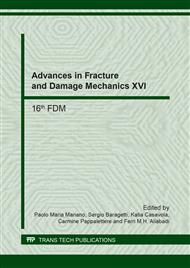p.329
p.333
p.337
p.341
p.345
p.349
p.353
p.359
p.363
Discrete Modeling of Strain Rate Effect in Concrete Fracture
Abstract:
Concrete fracture can be simulated in static regime, however, it is a dynamical process. For very slow loading rates, the kinetic energy is negligible compared to the energy dissipated by fracturing, and the influence of inertia can be neglected. In all other cases, neglecting the influence of inertia forces can lead to improper results. With increasing loading rate, increase in strength and energy dissipation as well as changes in crack pattern can be observed. The contribution presents dynamical simulations of experiments on concrete specimens under various displacement rates, from very slow, quasi-static, to high displacement rates. The simulations are calculated using discrete particle model, the material is represented by a system of interconnected ideally rigid polyhedral particles. The solution of equations of motion is calculated using implicit time integration Newmark scheme. The constitutive behavior of the material is strain rate independent. For high strain rates the influence of inertia forces dominates and is mainly responsible for increase in loading forces as well as for change in the crack pattern and crack branching. The results obtained with the model are compared to experimental data from literature.
Info:
Periodical:
Pages:
345-348
Citation:
Online since:
September 2017
Authors:
Keywords:
Price:
Сopyright:
© 2017 Trans Tech Publications Ltd. All Rights Reserved
Share:
Citation:


